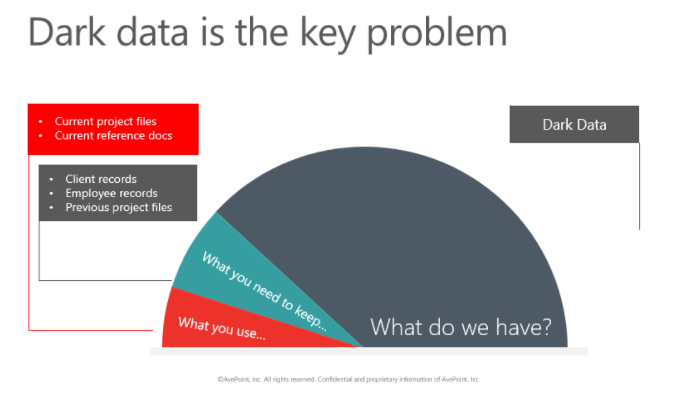Data Security, Compliance and Management Today: From Dark Data to GDPR

Data Security, Compliance and Management in 2018
In this day and age, your data is everything. For sales organizations, your data is customers, deal specifics, financial agreements, contracts — basically things that you’d REALLY rather not getting in to the wrong hands. If you’re in the healthcare industry, your data is patient records, prescriptions, and a million other things that could be the difference between life and death.
Be sure to check out our FREE on demand webinar, “Office 365 Compliance for Healthcare, Financial & Other Tightly Regulated Industries” and check out some questions and answers from the webinar here!
Obviously, this means that keeping data safe should be among the most important objectives for virtually every business. However, the reality is that data breaches and data loss does happen. Whether its the result of malice (hackers and other cybercriminals), oversight (user error, accidental deletion) or a software issue (corrupt files, natural disasters), if your business hasn’t had to handle a data security problem, you probably haven’t been in business for very long.
When data loss or a breach inevitably happens, it’s not just your reputation and customer confidence that can take a hit. These breaches and losses have a direct effect on your bottom line.
The average cost to an organization for each lost or stolen record in the healthcare industry is $380. For businesses in finance, that cost is $245 and for companies in education, that number is $200. The point is that it’s not just a slap on the wrist, “off you go” kind of dilemma. Data security and privacy is taken EXTREMELY seriously and for good reason.
The present reality: old practices don’t measure up to new regulation
File shares still represent a major document repository for many organizations, but the reality is they just don’t offer the control necessary to meet today’s complex regulatory requirements around data privacy and records management.
As time goes on, more and more data is created and accumulated, and you know less and less about what’s actually living within those file shares.
Most organizations are required to maintain certain files for a specific period of time such as client and employee records, or certain files/contracts from previous engagements.
But there’s a vast amount of data that simply cannot be accounted for. For example you could have four versions of the same file that a user created as drafts for some task before he left, that no one even realizes exists, let alone what’s within them — a.k.a the dreaded dark data.
All of that dark data sitting there, no one really knows what it’s for, who actually owns it, or what type of information it contains.

The General Data Protection Regulation (GDPR)
As data has become ubiquitous among businesses and other organizations, the need for regulation of that data has become clear. One such regulation is the GDPR, set to go into effect on May 25th of 2018. In essence, the GDPR imposes strict fines for data violations for businesses in the EU or those who do business in EU countries with EU customer data.
Becoming GDPR compliant may seem like a daunting — or even scary — task, but what’s even scarier are the penalties for those not in compliance — up to $20 million. However, if you take the number of records lost from Equifax and multiply that per record breach, the cost ends up in the 20-30 billions…not exactly chump change.
Compliant Migration
Compliant migration is something organizations are more and more interested in undergoing, rather than just the traditional lift and shift. This is mainly due to the fact that security through obscurity is no longer a viable approach. This is because breaches happen and fines are getting higher and higher.
It also ties in with the stats from IDC/IDG/Forbes on the cost of data management and if you identify X amount of TB of ROT/Duplicate data and multiply it by the annual data management cost which is $3000 USD a year, that can be a direct cost savings for CTO/CIOs, while lowering the risk exposure.
Like what you read? Be sure to subscribe to our blog to stay in the fold for all things Office 365, SharePoint and more!



